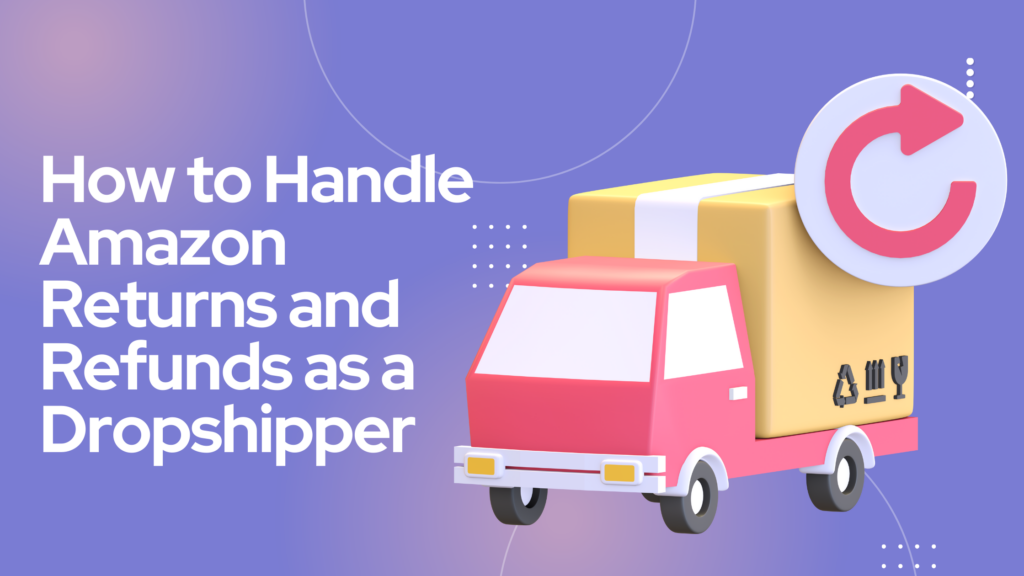How to Handle Amazon Returns and Refunds as a Dropshipper
As a dropshipper on Amazon, returns and refunds are inevitable. Understanding Amazon’s return policy, setting up your own return policy, and efficiently handling returns and refunds are crucial for the success of your dropshipping business. By following best practices and implementing effective strategies, you can minimize losses and maintain customer satisfaction.
Understanding Amazon’s Return Policy
Before diving into the details of handling returns and refunds, it is essential to familiarize yourself with Amazon’s return policy. Amazon offers a generous and customer-centric return policy, allowing customers to return most items within 30 days of receipt. As a dropshipper, it is important to align your own return policy with Amazon’s policy to avoid discrepancies and provide seamless customer service.
Preventing Returns and Refunds
One of the most effective ways to handle returns and refunds is to prevent them from happening in the first place. By implementing preventive measures, you can reduce the likelihood of customers wanting to return items. Here are some strategies to consider:
Accurate Product Descriptions and High-Quality Images
Providing accurate and detailed product descriptions, along with high-quality images, can help set clear expectations for customers. Include information about the product’s features, dimensions, materials, and any potential limitations. By ensuring that customers have a comprehensive understanding of the product before purchasing, you can minimize the chances of dissatisfaction and subsequent returns.
Reliable Suppliers and Quality Control
Working with reliable suppliers is crucial for maintaining product quality and reducing the risk of returns. Conduct thorough research and due diligence to find suppliers with a track record of delivering high-quality products. Implement quality control measures to inspect products before they are shipped to customers. This can help identify any potential issues or defects and allow you to address them proactively.
Efficient Shipping and Packaging
Fast and reliable shipping, along with proper packaging, can significantly reduce the likelihood of returns due to damaged or delayed items. Choose shipping methods that offer tracking and insurance to ensure that products arrive safely and on time. Invest in sturdy packaging materials to protect items during transit. By prioritizing efficient shipping and secure packaging, you can enhance the overall customer experience and minimize returns.
Setting Up Your Return Policy
Creating a clear return policy is essential for managing return and refund requests efficiently. Your return policy should align with Amazon’s policy while clearly stating your specific terms and conditions. Here are key elements to include in your return policy:
Clear and Concise Refund Policy
Specify the time frame within which customers must request a refund and the process they need to follow. It is important to set realistic expectations for customers while also protecting your business from fraudulent refund requests.
Terms and Conditions
In addition to the refund policy, include terms and conditions that outline any specific requirements or limitations for returns. For example, you may specify that products must be returned in their original packaging and in unused condition. Clearly communicate any restocking fees or return shipping costs that may apply.
Return Process Instructions
Provide step-by-step instructions on how customers can initiate a return. Include details on how they can contact your customer support team and obtain a return label, if applicable. Clearly outline the time frame within which customers should return the item and any specific instructions for packaging and shipping.
Handling Returns
When a customer requests a return, it is crucial to handle the process promptly and efficiently. Effective communication and a smooth return process can help maintain customer satisfaction and minimize the impact on your business. Here are the key steps to follow when handling returns:
Communicating with Customers
When a customer requests a return, prioritize clear and prompt communication. Acknowledge the customer’s request and provide reassurance that their concern is being addressed. Respond to their inquiries promptly and professionally, ensuring that they are aware of the return process and any necessary steps they need to follow.
Evaluating Return Requests
Carefully evaluate each return request to ensure that it aligns with your refund policy. Verify the reason for the return and assess the condition of the item to determine its eligibility for a refund. If necessary, request additional information or evidence from the customer to support their claim. By conducting thorough evaluations, you can minimize the risk of fraudulent returns.
Providing Return Labels
If the return is approved, provide the customer with a return label to facilitate the shipping process. Depending on the circumstances and your arrangements with suppliers, you may choose to offer prepaid return labels or reimburse customers for return shipping costs. Clear instructions on how to package and ship the item should also be provided to ensure that it is returned in its original condition.
Refunding Customers
Processing refunds accurately and promptly is crucial for maintaining customer trust and satisfaction. Here are the key steps to follow when refunding customers:
Processing Refunds
Once the returned item is received and inspected, process the refund promptly. Ensure that the refund amount aligns with your refund policy and any applicable restocking fees. Clearly communicate with the customer regarding the refund process and provide estimated timelines for when they can expect to receive the refund.
Handling Restocking Fees
If your return policy includes restocking fees, clearly communicate this to the customer and deduct the appropriate amount from the refund. Restocking fees are typically charged to cover the costs associated with processing the return and making the item available for resale.
Dealing with Damaged or Defective Products
Despite preventive measures, there may be instances when customers receive damaged or defective products. Handling these situations swiftly and effectively is crucial for maintaining customer satisfaction. Here are some steps to take when dealing with damaged or defective products:
Inspecting Returned Items
When a customer returns a damaged or defective item, thoroughly inspect it to verify the validity of their claim. Document any damages or defects and take photographs as evidence. This information will be essential when communicating with suppliers or seeking compensation for the damaged product.
Contacting Suppliers for Replacements
If the returned item is confirmed to be damaged or defective, contact your supplier to request a replacement. Provide them with detailed information and evidence, such as photographs and a description of the issue. Work with your supplier to ensure that the replacement is shipped promptly to the customer to minimize any delays or further inconvenience.
Seeking Compensation for Damaged Products
In some cases, seeking compensation for damaged products may be necessary, especially if the supplier is responsible for the damage. Contact your supplier and provide them with the necessary evidence to support your claim. Seek reimbursement for the cost of the damaged product, as well as any associated shipping or return costs.
Managing Returns for International Orders
If you are dropshipping internationally, it is important to understand the specific return policies and procedures for each country. International returns can be more complex due to shipping costs, customs duties, and varying regulations. Here are some considerations when managing returns for international orders:
International Return Policies
Research and understand the return policies of the countries you are dropshipping to. Some countries may have stricter regulations or higher return shipping costs. Familiarize yourself with these policies to ensure compliance and provide accurate information to your customers.
Shipping Costs and Customs Duties
When processing international returns, be aware of the associated shipping costs and customs duties. Communicate these costs clearly to your customers and determine whether they are responsible for covering these expenses. Providing transparent information can help avoid misunderstandings and ensure a smooth return process.
Monitoring Return Metrics
Tracking and analyzing return metrics is essential for evaluating the effectiveness of your return management strategies. By monitoring these metrics, you can identify trends, potential issues, and areas for improvement. Here are some key return metrics to monitor:
Tracking Return Rates
Calculate and track your return rates to assess the overall performance of your dropshipping business. Compare return rates across different products, suppliers, and time periods to identify any patterns or areas of concern. High return rates may indicate product quality issues or inadequate customer support.
Analyzing Customer Feedback
Pay attention to customer feedback regarding returns and refunds. Analyze common reasons for returns, customer satisfaction levels, and any recurring issues. Use this feedback to improve your product descriptions, supplier selection, and overall customer experience.
Reselling Returned Items
In some cases, it may be possible to resell returned items to minimize losses. Implementing a process for reconditioning and repackaging returned items can help recoup some of the costs. Alternatively, consider collaborating with liquidation and return centers to sell returned items in bulk. By exploring these options, you can mitigate the financial impact of returns.
Proactive Customer Support
Providing proactive customer support can significantly reduce the likelihood of returns and refunds. By addressing customer concerns and providing satisfactory solutions, you can enhance customer satisfaction and loyalty. Here are some strategies for proactive customer support:
Fast Response Times
Respond to customer inquiries and concerns promptly. Aim to provide a response within 24 hours or less to show that you value their time and concerns. Timely communication can help resolve issues before they escalate and reduce the chances of customers wanting to return items.
Offering Solutions and Alternatives
When customers express dissatisfaction or concerns, offer solutions or alternatives. This could involve suggesting similar products, providing detailed information, or offering discounts or incentives. By going the extra mile to find solutions, you can salvage the customer relationship and potentially avoid a return or refund.
Providing Excellent Customer Service
Consistently providing excellent customer service is vital for building trust and loyalty. Train your customer support team to handle inquiries and concerns professionally and empathetically. By exceeding customer expectations and delivering exceptional service, you can create a positive reputation and minimize the likelihood of returns.
Minimizing Returns in the Future
Continuous improvement is key to minimizing returns and refunds in the long run. By learning from customer feedback, tracking return metrics, and implementing quality control measures, you can reduce the likelihood of returns. Here are some strategies to consider:
Continuous Improvement
Regularly review and update your product descriptions, images, and customer support processes. Stay updated with the latest industry trends and customer preferences to ensure that your products meet their expectations. Continuously seek opportunities for improvement and implement changes accordingly.
Feedback and Reviews
Encourage customers to provide feedback and reviews about their purchasing experience. Use this feedback to identify areas for improvement and address any issues proactively. Positive reviews can also help build trust and credibility, reducing the likelihood of returns.
Quality Control Strategies
Implement robust quality control strategies to minimize the risk of receiving and shipping defective products. Conduct regular inspections, work closely with reliable suppliers, and establish clear quality standards. By prioritizing product quality, you can reduce returns and maintain customer satisfaction.
In conclusion, effectively handling Amazon returns and refunds is crucial for the success of your dropshipping business. By understanding Amazon’s return policy, preventing returns, setting up a clear return policy, and implementing efficient handling processes, you can minimize losses and maintain customer satisfaction. By continuously monitoring return metrics, providing proactive customer support, and seeking opportunities for improvement, you can further reduce the likelihood of returns in the future. Implementing these best practices will help you establish a reputation for reliability and build a successful dropshipping business on Amazon.






